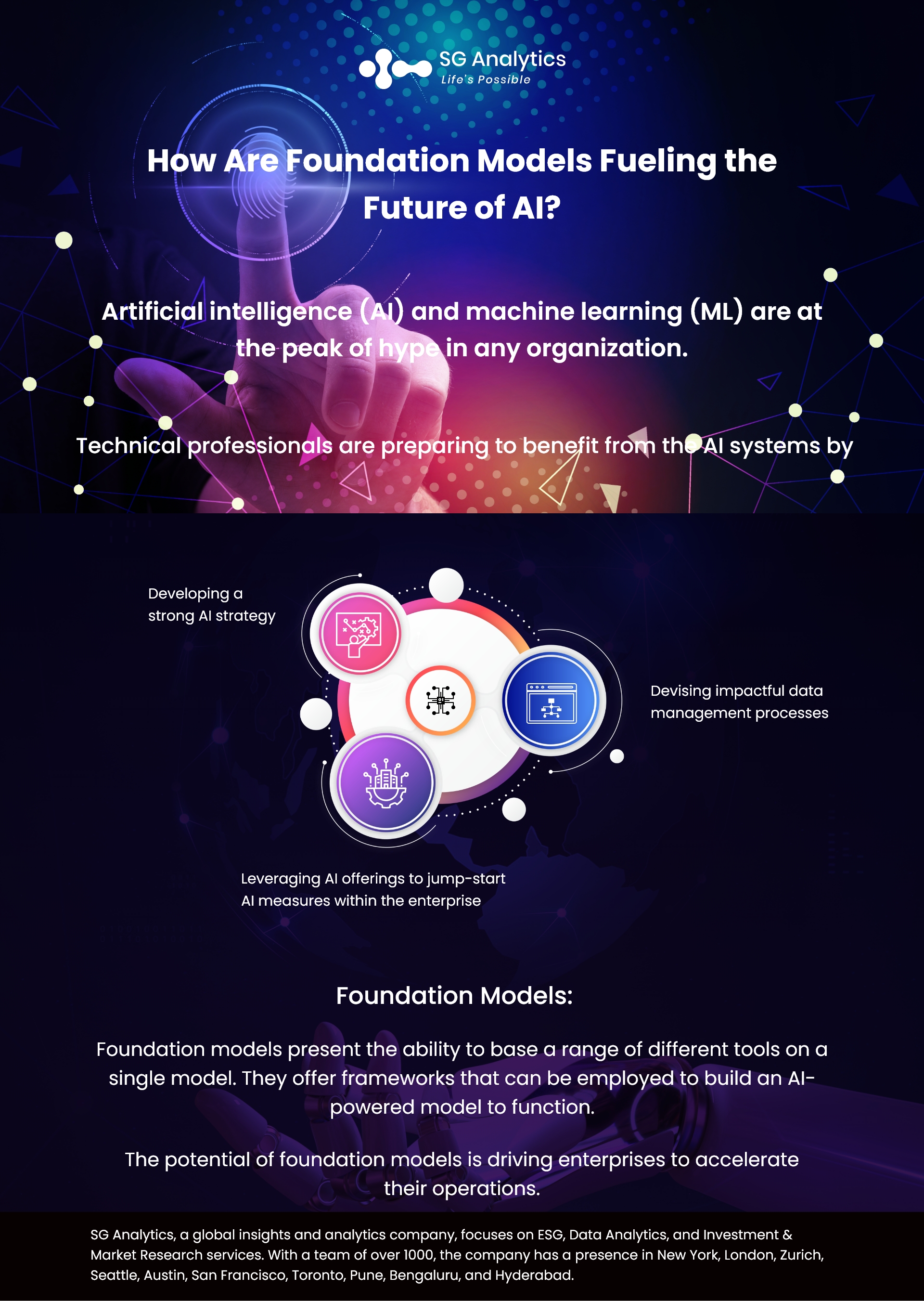Today AI systems are undergoing a paradigm shift. With the rise of intelligently trained models trained at a massive scale, organizations are employing smart systems to automate their operations and capabilities for growth. Leaders are leaping ahead on this most promising path toward automating human tasks. One of the remarkable aspects of this incredible growth is that it has started a widespread belief that incorporating AI-driven parameters into their operational models will help in reaching a point of exceptional returns.
AI models are fed with data and several parameters to make their operations better and better. That implies building and running artificial intelligence (AI) models that incorporate a number of parameters or coefficients within the program. The new models are showing remarkable growth and have outperformed older machine-learning models. They have also exhibited new capabilities in their assigned tasks.

Laying the Foundation for AI (artificial intelligence)
AI has the potential to authorize organizations to remain competitive and pursue new directions with their solutions. IT leaders are walking down the AI path and incorporating AI systems into their everyday operations. By 2022, organizations working on AI projects will be required to demonstrate competency along with an understanding of ethical and responsible AI practices.
Artificial intelligence (AI) and machine learning (ML) today are at the peak of hype in any organization. While these technologies are still emerging, they are delivering impactful and practical benefits to help solve real-world problems.
Technical professionals are now preparing to benefit from the AI systems by employing the right foundational steps:
-
Developing a strong AI strategy
-
Devising impactful data management processes
-
Leveraging AI offerings to jump-start AI measures within the enterprise
The earlier generation AI models were good for only one specific purpose. The new AI models can be reassigned to different types of problems as they offer relatively easy fine-tuning. The measure of the extent employed to identify this trait within the industry is called foundation models.
Foundation models offer the ability to base a range of different tools on a single model. With AI now moving into its industrial age, businesses are employing the models to potentially enhance their economic impacts.
Read more: Driving Sustainable Innovations: AI for ESG Data Challenges
.jpg)
A Deeper Dive into Foundation Models
Models including BERT, T5, Codex, DALL-E, and CLIP form the base layer for new applications in everything, ranging from computer vision to sequence research, speech recognition, and coding. The collective term for these base systems is referred to as "foundation models." The term was coined in a recent study by Liang and a list of computer scientists, sociologists, and philosophers. These foundation models or systems are everywhere and are often referred to as self-supervised AI systems. These AI systems are starting to dominate their respective fields.
The term foundation models evoke the central importance of these systems within whole ecosystems of software applications. A foundation model offers the AI system all sorts of frameworks that can be employed to build an AI-powered model to function.
Reliability forms the central core for the success of any foundation. These foundation models satisfy the same criterion and act as a bedrock of AI systems.
How do Foundation Models Learn?
When it comes to foundation models, all paths lead to BERT - Bidirectional Encoder Representations from Transformers. Developed by Google, this natural language processing algorithm is incorporated to better interpret the context underlying search queries.
The systems are trained using a method often known as self-supervised learning. This method enables the model to make linkages between reams of unstructured data. Google started using BERT on US search inquiries in October 2019. After two months of trial, it started handling queries in more than 70 other languages. BERT's training model is built on long-established techniques in NLP research. Developers lean heavily on BERT and other self-supervised learning models to train their AI systems.
Read more: The Age of Digital Transformation: Top AI and ML 2022 Trends

The Phase Change in AI triggered by Foundation Models
All machine-learning models are based on neural networks. Neural networks are programs that mimic the same ways our brain cells interact with each other.
They describe the weights of the connections between the virtual neurons in the model that is developed. The systems are trained to respond to inputs along with the sort of outputs that are required. For decades neural nets were interesting in principle but not much use in practice. The AI (artificial intelligence) breakthrough has enabled computers to become powerful enough to run on huge amounts of training data.
AI systems have enabled businesses to learn from thousands, or millions, of examples, to assist in better understanding the world, as well as to find new solutions to difficult problems. The large-scale AI models are enabling systems to understand operations related to talking or writing by employing natural language processing and understanding programs used every day. The systems have allowed developers to build generative models that can create new work. Many new AI systems are assisting in solving all sorts of real-world problems. However, the creation and deployment of each new system often require considerable time and resources.
The AI-driven models have to learn to understand and recognize the data in the dataset and then apply it to the use case. From recognizing language to generating new modules, AI systems are trained on a derived framework of one large natural-language processing model.
The capabilities and dramatic performance improvements of applying foundation models are leading to a new status quo: a single AI model trained on raw datasets. This model can then be adapted for a wide range of applications. The AI multimodal system is trained on images, text, and other data using massive computational resources.
Studies predict that the future of AI will be dominated by foundation models. However, they need to be trained on discriminating sources of information rather than the internet. One possible solution offered by scientists is National Research Cloud - a vast database curated with care by the US AI research community. It is aimed to offer an alternative to scraping data from the internet and assist in reducing the biases that can creep into foundation models.
Read more: Bias in Artificial Intelligence: Is Diversity the Key to the Future Of AI?

The Biden administration has also extended its support to this ideation to scope out what its implementation would look like. Another effective solution for the foundation model involves instituting new rules on the quality and origin of data being employed. In this approach, AI models routinely screen data for bias by running a series of bespoke tests.
The entire history of machine learning and deep learning, along with AI, has been one of centralization. While the regulations and practices are formulated, the outsize influence gained by models like GPT-3 and BERT seems inevitable. It is now time for tech organizations to inculcate ethical values before the harms of individual models perpetuate in the application ecosystems.
The future of AI is flexible as reusable AI models are being applied to any domain or industry task. The last decade has experienced an explosion of applications for artificial intelligence. AI has gone from a purely academic endeavour to an empowering force powering actions across different domains and affecting the lives of millions.

Final Thoughts
AI-based transcription tools are making the tiresome aspect far easier. Earlier, foundation models seemed like a thing of the future. Foundation models help in taking away the heavy lifting of figuring out the aspects of different domains.
Foundation models are dramatically accelerating AI adoption in enterprises. By reducing labelling requirements, they are making it much easier for businesses to dive in and derive highly accurate and efficient AI-driven automation. Many organizations are now deploying AI in a wider range of mission-critical situations. Their goal is to inculcate the power of foundation models in the operations of every enterprise to offer a frictionless hybrid-cloud environment.
It is an exciting time in artificial intelligence and machine learning research. The potential of foundation models is enabling enterprises to accelerate their operations.
With a presence in New York, San Francisco, Austin, Seattle, Toronto, London, Zurich, Pune, Bengaluru, and Hyderabad, SG Analytics, a pioneer in Research and Analytics, offers tailor-made services to enterprises worldwide.
A leader in the Technology domain, SG Analytics partners with global technology enterprises across market research and scalable analytics. Contact us today if you are in search of combining market research, analytics, and technology capabilities to design compelling business outcomes driven by technology.









